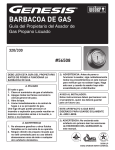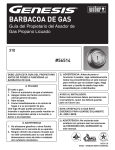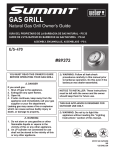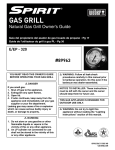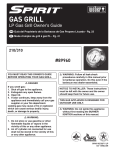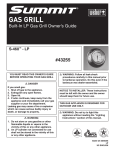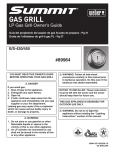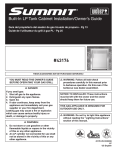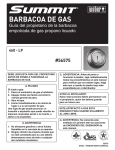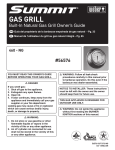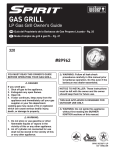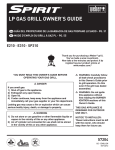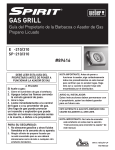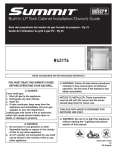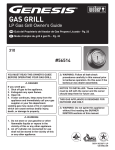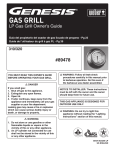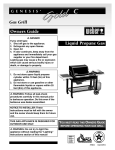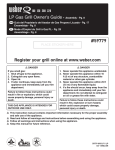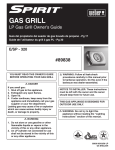Download Weber Summit 56214 Owner's Manual
Transcript
GAS GRILL LP Gas Grill Owner’s Guide ESNA Guía del Propietario del Asador de Gas Licuado de Propano - Pg. 29 Guide de L’Utilisateur du Grill à Gaz PL - Pg. 57 620 #56214 You must read this Owner’s Guide before operating your gas grill. m DANGER If you smell gas: 1.Shut off gas to the appliance. 2.Extinguish any open flames. 3.Open lid. 4.If odor continues, keep away from the appliance and immediately call your gas supplier or your fire department. Leaking gas may cause a fire or explosion which can cause serious bodily injury or death, or damage to property. m WARNING: mWARNING: Follow all leak-check procedures carefully in this manual prior to barbecue operation. Do this even if the barbecue was dealer-assembled. NOTICE TO INSTALLER: These instructions must be left with the owner and the owner should keep them for future use. THIS GAS APPLIANCE IS DESIGNED FOR OUTDOOR USE ONLY. mWARNING: Do not try to light this appliance without reading the “MAIN BURNER IGNITION” section of this manual. 1.Do not store or use gasoline or other flammable liquids or vapors in the vicinity of this or any other appliance. 2.An LP cylinder not connected for use shall not be stored in the vicinity of this or any other appliance. 56214 02/01/10 LP US - ENGLISH WARNINGS m DANGER Failure to follow the Dangers, Warnings and Cautions contained in this Owner’s Manual may result in serious bodily injury or death, or in a fire or an explosion causing damage to property. m WARNINGS mDo not store a spare or disconnected liquid propane cylinder under or near this barbecue. mImproper assembly may be dangerous. Please follow the assembly instructions carefully. mAfter a period of storage, and/or nonuse, the Weber® gas barbecue should be checked for gas leaks and burner obstructions before use. See instructions in this manual for correct procedures. mDo not operate the Weber® gas barbecue if there is a gas leak present. mDo not use a flame to check for gas leaks. m Combustible materials should never be within 24 inches (61 cm) of the back or sides of your Weber® gas barbecue. mDo not put a barbecue cover or anything flammable on, or in the storage area under the barbecue. m Your Weber® gas barbecue should never be used by children. Accessible parts of the barbecue may be very hot. Keep young children away while it is in use. m You should exercise reasonable care when operating your Weber® gas barbecue. It will be hot during cooking or cleaning and should never be left unattended, or moved while in operation. mShould the burners go out while in operation, turn all gas valves off. Open the lid and wait five minutes before attempting to relight, using the lighting instructions. mDo not use charcoal or lava rock in your Weber® gas barbecue. mNever lean over open grill or place hands or fingers on the front edge of the cooking box. mShould a grease fire occur, turn off all burners and leave lid closed until fire is out. mDo not enlarge valve orifices or burner ports when cleaning the valves or burners. mThe Weber® gas barbecue should be thoroughly cleaned on a regular basis. mLiquid propane gas is not natural gas. The conversion or attempted use of natural gas in a liquid propane unit or liquid propane gas in a natural gas unit is dangerous and will void your warranty. mDo not attempt to disconnect any gas fitting while your barbecue is in operation. mUse heat-resistant barbecue mitts or gloves when operating barbecue. m Keep any electrical supply cord and the fuel supply hose away from any heated surfaces. m Combustion byproducts produced when using this product contain chemicals known to the state of California to cause cancer, birth defects, or other reproductive harm. mDo not use this barbecue unless all parts are in place. The unit must be properly assembled according to the assembly instructions. mDo not build this model of grill in any built-in or slide in construction. Ignoring this Warning could cause a fire or an explosion that can damage property and cause serious bodily injury or death. mProposition 65 Warning: Handling the brass material on this product exposes you to lead, a chemical known to the state of California to cause cancer, birth defects or other reproductive harm. (Wash hands after handling this product.) LIQUID PROPANE GAS UNITS ONLY: mUse the pressure regulator and hose assembly that is supplied with your Weber® gas barbecue. mDo not attempt to disconnect the gas regulator and hose assembly or any gas fitting while your barbecue is in operation. mA dented or rusty liquid propane cylinder may be hazardous and should be checked by your liquid propane supplier. Do not use a liquid propane cylinder with a damaged valve. mAlthough your liquid propane cylinder may appear to be empty, gas may still be present, and the cylinder should be transported and stored accordingly. mIf you see, smell or hear the hiss of escaping gas from the liquid propane cylinder: 1.Move away from liquid propane cylinder. 2.Do not attempt to correct the problem yourself. 3. Call your fire department. 2 TABLE OF CONTENTS WARNINGS. . . . . . . . . . . . . . . . . . . . . . . . . . . . . . . . . . . . . . . . . . 2 MAINTENANCE. . . . . . . . . . . . . . . . . . . . . . . . . . . . . . . . . . . . . 24 CLEANING. . . . . . . . . . . . . . . . . . . . . . . . . . . . . . . . . . . . . . . . . . . . . . . . . . . . . . . 24 TABLE OF CONTENTS. . . . . . . . . . . . . . . . . . . . . . . . . . . . . . . . . 3 WEBER® SPIDER/INSECT SCREENS. . . . . . . . . . . . . . . . . . . . . . . . . . . . . . . . . 24 MAIN BURNER CLEANING. . . . . . . . . . . . . . . . . . . . . . . . . . . . . . . . . . . . . . . . . . 24 EXPLODED VIEW. . . . . . . . . . . . . . . . . . . . . . . . . . . . . . . . . . . . . 4 REPLACING MAIN BURNERS . . . . . . . . . . . . . . . . . . . . . . . . . . . . . . . . . . . . . . . 25 SIDE BURNER MAINTENANCE . . . . . . . . . . . . . . . . . . . . . . . . . . . . . . . . . . . . . . 26 EXPLODED VIEW LIST . . . . . . . . . . . . . . . . . . . . . . . . . . . . . . . . 5 ANNUAL MAINTENANCE. . . . . . . . . . . . . . . . . . . . . . . . . . . . . . . . . . . . . . . . . . . 27 WARRANTY . . . . . . . . . . . . . . . . . . . . . . . . . . . . . . . . . . . . . . . . . 6 GENERAL INSTRUCTIONS. . . . . . . . . . . . . . . . . . . . . . . . . . . . . 7 CANADIAN INSTALLATION. . . . . . . . . . . . . . . . . . . . . . . . . . . . . . . . . . . . . . . . . . . 7 OPERATING. . . . . . . . . . . . . . . . . . . . . . . . . . . . . . . . . . . . . . . . . . . . . . . . . . . . . . 7 STORAGE AND/OR NONUSE. . . . . . . . . . . . . . . . . . . . . . . . . . . . . . . . . . . . . . . . . 7 GAS INSTRUCTIONS. . . . . . . . . . . . . . . . . . . . . . . . . . . . . . . . . . 8 SAFE HANDLING TIPS FOR LIQUID PROPANE GAS CYLINDERS . . . . . . . . . . . 8 IMPORTANT LP CYLINDER INFORMATION . . . . . . . . . . . . . . . . . . . . . . . . . . . . . 9 LEAK CHECK PREPARATION. . . . . . . . . . . . . . . . . . . . . . . . . . . . . . . . . . . . . . . . . 9 CHECK FOR GAS LEAKS. . . . . . . . . . . . . . . . . . . . . . . . . . . . . . . . . . . . . . . . . . . 11 REFILLING THE LIQUID PROPANE CYLINDER. . . . . . . . . . . . . . . . . . . . . . . . . . 13 LIGHT FEATURES . . . . . . . . . . . . . . . . . . . . . . . . . . . . . . . . . . . 13 WEBER® GRILL OUT™ HANDLE LIGHT. . . . . . . . . . . . . . . . . . . . . . . . . . . . . . . 13 BEFORE USING THE GRILL . . . . . . . . . . . . . . . . . . . . . . . . . . . 14 FUEL LEVEL . . . . . . . . . . . . . . . . . . . . . . . . . . . . . . . . . . . . . . . . . . . . . . . . . . . . . 14 SLIDE OUT GREASE TRAY AND DISPOSABLE DRIP PAN. . . . . . . . . . . . . . . . . 14 SNAP IGNITION OPERATION . . . . . . . . . . . . . . . . . . . . . . . . . . 15 MAIN BURNER IGNITION & USAGE. . . . . . . . . . . . . . . . . . . . . 16 MAIN BURNER IGNITION. . . . . . . . . . . . . . . . . . . . . . . . . . . . . . . . . . . . . . . . . . . 16 TO EXTINGUISH. . . . . . . . . . . . . . . . . . . . . . . . . . . . . . . . . . . . . . . . . . . . . . . . . . 16 MAIN BURNER MANUAL IGNITION . . . . . . . . . . . . . . . . . . . . . . . . . . . . . . . . . . 17 TO EXTINGUISH. . . . . . . . . . . . . . . . . . . . . . . . . . . . . . . . . . . . . . . . . . . . . . . . . . 17 GRILLING TIPS & HELPFUL HINTS. . . . . . . . . . . . . . . . . . . . . 18 COOKING METHODS. . . . . . . . . . . . . . . . . . . . . . . . . . . . . . . . . 19 DIRECT COOKING . . . . . . . . . . . . . . . . . . . . . . . . . . . . . . . . . . . . . . . . . . . . . . . . 19 INDIRECT COOKING . . . . . . . . . . . . . . . . . . . . . . . . . . . . . . . . . . . . . . . . . . . . . . 19 SIDE BURNER IGNITION & USAGE . . . . . . . . . . . . . . . . . . . . . 20 SIDE BURNER IGNITION. . . . . . . . . . . . . . . . . . . . . . . . . . . . . . . . . . . . . . . . . . . 20 SIDE BURNER MANUAL IGNITION . . . . . . . . . . . . . . . . . . . . . . . . . . . . . . . . . . . 21 TROUBLESHOOTING. . . . . . . . . . . . . . . . . . . . . . . . . . . . . . . . . 22 SIDE BURNER TROUBLESHOOTING. . . . . . . . . . . . . . . . . . . . . . . . . . . . . . . . . 23 GRILL OUT™ HANDLE LIGHT TROUBLESHOOTING. . . . . . . . . . . . . . . . . . . . . . . . . . . . . . . . . 23 www.weber.com® 3 EXPLODED VIEW SUMMIT 620_LP_US_010810 1 2 3 4 5 6 7 8 9 10 11 12 13 27 14 28 15 16 29 30 31 17 32 18 19 20 33 21 22 34 35 36 23 37 38 39 24 25 26 40 41 42 43 44 45 4 EXPLODED VIEW LIST 1. Shroud Hardware 16. Knob 31. Hose / Regulator 2. Shroud 17. Water Baffle / Heat Shield 32. Side Burner Lid 3. Thermometer 18. Disposable Drip Pan 33. Side Burner Table 4. Thermometer Bezel 19. Slide Out Grease Tray 34. Side Burner Hose 5. Handle 20. Catch Pan 35. Right Tool Holder 6. Grill Out™ Handle Light 21. Catch Pan Holder 36. Frame Support 7. Warming Rack 22. Left Door 37. Back Panel 8. Cooking Grates 23. Door Handles 38. Right Frame Panel 9. Flavorizer® Bars 24. Right Door 39. Tank Scale 10. Burner Tubes 25. Left Frame Panel 40. LED Tank Scale Assembly 11. Side Table 26. Bottom Panel 41. Tank Glides 12. Left Tool Holder 27. Side Burner 42. Matchstick Holder 13. Manifold 28. Cookbox 43. Front Frame Support 14. Control Panel 29. Bulkhead 44. Caster 15. Knob Bezel 30. Manifold Hose 45. Locking Caster www.weber.com® 5 WARRANTY Weber-Stephen Products Co. (Weber) hereby warrants to the ORIGINAL PURCHASER of this Weber® gas grill that it will be free of defects in material and workmanship from the date of purchase as follows: Aluminum castings, Stainless steel shroud, Porcelain-enameled shroud, Stainless steel burners tubes, Stainless steel cooking grates, Stainless steel Flavorizer® bars, Porcelain-enameled cast-iron cooking grates, Porcelain-enameled cooking grates, Porcelain-enameled Flavorizer® bars, Infrared rotisserie burner, All remaining parts, 25-years (2 years on paint; excludes fading) 25-years 25-years 10-years 5-years no rust through or burn through 5-years no rust through or burn through 5-year no rust through or burn through 3-years no rust through or burn through 2-years no rust through or burn through 2-years 2-years when assembled and operated in accordance with the printed instructions accompanying it. Weber may require reasonable proof of your date of purchase. THEREFORE, YOU SHOULD RETAIN YOUR SALES SLIP OR INVOICE. This Limited Warranty shall be limited to the repair or replacement of parts that prove defective under normal use and service and which on examination shall indicate, to Weber’s satisfaction, they are defective. Before returning any parts, contact the Customer Service Representative in your area using the contact information on our website. If Weber confirms the defect and approves the claim, Weber will elect to replace such parts without charge. If you are required to return defective parts, transportation charges must be prepaid. Weber will return parts to the purchaser, freight or postage prepaid. This Limited Warranty does not cover any failures or operating difficulties due to accident, abuse, misuse, alteration, misapplication, vandalism, improper installation or improper maintenance or service, or failure to perform normal and routine maintenance, including but not limited to damage caused by insects within the burner tubes, as set out in this owner’s manual. Deterioration or damage due to severe weather conditions such as hail, hurricanes, earthquakes or tornadoes, discoloration due to exposure to chemicals either directly or in the atmosphere, is not covered by this Limited Warranty. There are no other express warrants except as set forth herein and any applicable implied warranties of merchantability and fitness are limited in duration to the period of coverage of this express written Limited Warranty. Some regions do not allow limitation on how long an implied warranty lasts, so this limitation may not apply to you. Weber is not liable for any special, indirect or consequential damages. Some regions do not allow the exclusion or limitation of incidental or consequential damages, so this limitation or exclusion may not apply to you. Weber does not authorize any person or company to assume for it any other obligation or liability in connection with the sale, installation, use, removal, return, or replacement of its equipment; and no such representations are binding on Weber. This Warranty applies only to products sold at retail. WEBER-STEPHEN PRODUCTS CO. Customer Service Center 1890 Roselle Road, Suite 308 Schaumburg, IL 60195 USA For replacement parts call: 1-800-446-1071 Visit www.weber.com®, select your country of origin, and register your grill today. ◆ 6 GENERAL INSTRUCTIONS Your Weber® gas barbecue is a portable outdoor cooking appliance. With the Weber® gas barbecue you can grill, barbecue, roast and bake with results that are difficult to duplicate with indoor kitchen appliances. The closed lid and Flavorizer® bars produce that “outdoor” flavor in the food. The Weber® gas barbecue is portable so you can easily change its location in your yard or on your patio. Portability means you can take your Weber® gas barbecue with, if you move. Liquid Propane (LP) gas supply is easy to use and gives you more cooking control than charcoal fuel. • These instructions will give you the minimum requirements for assembling your Weber® gas barbecue. Please read the instructions carefully before using your Weber® gas barbecue. Improper assembly can be dangerous. • Not for use by children. • If there are local codes that apply to portable gas grills, you will have to conform to them. Installation must conform with local codes or, in the absence of local codes, with either the National Fuel Gas Code, ANSI Z223.1/NFPA 54, Natural Gas and Propane Installation Code, CSA B149.1, or Propane Storage and Handling Code, B149.2, or the Standard for Recreational Vehicles, ANSI A 119.2/NFPA 1192, and CSA Z240 RV Series, Recreational Vehicle Code, as applicable. • The pressure regulator supplied with the Weber® gas barbecue must be used. This regulator is set for 11 inches of water column (pressure). • This Weber® gas barbecue is designed for use with liquid propane (LP) gas only. Do not use with natural (piped in city) gas. The valves, orifices, hose and regulator are for LP gas only. • Do not use with charcoal fuel. • Check that the area under the control panel and the bottom tray are free from debris that might obstruct the flow of combustion or ventilation air. • The areas around the LP cylinder must be free and clear from debris. • Replacement pressure regulators and hose assemblies must be those specified by Weber-Stephen Products Co. ◆ STORAGE AND/OR NONUSE • The gas must be turned off at the liquid propane cylinder when the Weber® gas barbecue is not in use. • When the Weber® gas barbecue is stored indoors, the gas supply must be DISCONNECTED and the LP cylinder stored outdoors in a well-ventilated space. • LP cylinder must be stored outdoors in a well -ventilated area out of reach of children. Disconnected LP cylinder must not be stored in a building, garage or any other enclosed area. • When the LP cylinder is not disconnected from the Weber® gas barbecue, the appliance and LP tank must be kept outdoors in a well-ventilated space. • The Weber® gas barbecue should be checked for gas leaks and any obstructions in the burner tubes before using. (See section: “MAINTENANCE/ANNUAL MAINTENANCE”). • Check that the areas under the control panel and the slide out bottom tray are free from debris that might obstruct the flow of combustion or ventilation air. • The Spider/Insect screens should also be checked for any obstructions. (See section: “MAINTENANCE/ANNUAL MAINTENANCE”). ◆ CANADIAN INSTALLATION These instructions, while generally acceptable, do not necessarily comply with the Canadian Installation codes, particularly with piping above and below ground. In Canada the installation of this appliance must comply with local codes and/or Standard CSA-B149.2 (Propane Storage and Handling Code). ◆ OPERATING mWARNING: Only use this barbecue outdoors in a wellventilated area. Do not use in a garage, building, breezeway or any other enclosed area. mWARNING: Keep ventilation openings for cylinder enclosure free and clear from debris. mWARNING: Your Weber® gas barbecue shall not be used under overhead combustible construction. mWARNING: Your Weber® gas barbecue is not intended to be installed in or on recreational vehicles and/or boats. mWARNING: Do not use the barbecue within 24 inches of combustible materials to the back or sides of the grill. mWARNING: The entire cooking box gets hot when in use. Do not leave unattended. mWARNING: Keep any electrical supply cord and the fuel supply hose away from any heated surface. mWARNING: Keep the cooking area clear of flammable vapors and liquids such as gasoline, alcohol, etc., and combustible materials. mWARNING: Never store an extra (spare) LP cylinder under or near the Weber® gas barbecue. mWARNING: The LP cylinder used with your barbecue must be with a listed OPD (Overfilling Prevention Device) and a QCC1 or Type 1 (CGA810) cylinder connection. The cylinder connection must be compatible with the barbecue connection. ◆ www.weber.com® 7 GAS INSTRUCTIONS SAFE HANDLING TIPS FOR LIQUID PROPANE GAS CYLINDERS • Liquid Propane (LP) gas is a petroleum product as are gasoline and natural gas. LP gas is a gas at regular temperatures and pressures. Under moderate pressure, inside a cylinder, LP gas is a liquid. As the pressure is released, the liquid readily vaporizes and becomes gas. • LP gas has an odor similar to natural gas. You should be aware of this odor. • LP gas is heavier than air. Leaking LP gas may collect in low areas and prevent dispersion. • To fill, take the LP cylinder to a gas propane dealer, or look up “gas-propane” in the phone book for other sources of LP gas. mWARNING: We recommend that your LP cylinder be filled at an authorized LP gas dealer, by a qualified attendant, who fills the tank by weight. IMPROPER FILLING IS DANGEROUS. • Air must be removed from a new LP cylinder before the initial filling. Your LP dealer is equipped to do this. • The LP cylinder must be installed, transported and stored in an upright position. LP cylinders should not be dropped or handled roughly. • Never store or transport the LP cylinder where temperatures can reach 125° F (too hot to hold by hand - for example: do not leave the LP cylinder in a car on a hot day). Note: A refill will last about 18-20 hours of cooking time at normal use. The fuel scale will indicate the propane supply so you can refill before running out. You do not have to run out before you refill. • Treat “empty” LP cylinders with the same care as when full. Even when the LP tank is empty of liquid there still may be gas pressure in the cylinder. Always close the cylinder valve before disconnecting. m CAUTION: Place dust cap on cylinder valve outlet whenever the cylinder is not in use. Only install the type of dust cap on the cylinder valve outlet that is provided with the cylinder valve. Other types of caps or plugs may result in leakage of propane. • Do not use a damaged LP cylinder. Dented or rusty LP cylinders or LP cylinders with a damaged valve may be hazardous and should be replaced with a new one immediately. • The joint where the hose connects to the LP cylinder must be leak tested each time the LP cylinder is reconnected. For example, test each time the LP cylinder is refilled. • Be sure the regulator is mounted with the small vent hole pointed downward so that it will not collect water. This vent should be free of dirt, grease, bugs etc. • The gas connections supplied with your Weber® gas appliance have been designed and tested to meet 100% CSA and ANSI requirements. mWARNING: Replacement LP tanks must match the regulator connection supplied with this Weber® gas appliance. Liquid Propane Cylinder Requirements • Check to be sure cylinders have a D.O.T. certification (1), and date tested (2) is within five years of use. Your LP gas supplier can do this for you. • All LP tank supply systems must include a collar to protect the cylinder valve. • The LP cylinder must be a 20-lb. size approximately 18¼ inches high, 12¼ inches in diameter. • The cylinder must be constructed and marked in accordance with the Specifications for LP - Gas Cylinders of the U.S. Department of Transportation (D.O.T.) or the National Standard of Canada, CAN/CSA-B339, Cylinders, Spheres and Tubes or Transportation of Dangerous Goods; and Commission, as applicable. Canadian Liquid Propane Cylinder Requirements Note: Your retailer can help you match a replacement tank to your barbecue. • The LP cylinder must be constructed and marked in accordance with the specifications for LP gas cylinders, T.C. ◆ 8 GAS INSTRUCTIONS IMPORTANT LP CYLINDER INFORMATION m DANGER NEVER store a spare LP cylinder under or near Weber® gas appliances. NEVER fill the tank beyond 80% full. Failure to follow these statements exactly may result in a fire causing death or serious injury. Weber® gas appliances are equipped for a cylinder supply system designed for vapor withdrawal. mWARNING: Only use Weber® gas appliances outdoors in a well-ventilated area. Do not use in a garage, building, breezeway or any other enclosed area. The proper filling methods for the filling of your cylinder are by weight or volume, as described in NFPA 58. Please make sure your filling station fills your LP cylinder by weight or volume. Ask your filling station to read purging and filling instructions on the LP cylinder before attempting to fill. ◆ LEAK CHECK PREPARATION Check That All Burner Valves Are Off Valves are shipped in the OFF position, but you should check to be sure that they are turned off. Check by pushing down and turning clockwise. If they do not turn, they are off. If they do turn, continue turning them clockwise until they stop, then they are off. The Liquid Propane Cylinder All Weber® liquid propane gas grill regulators are equipped with a UL-Listed tank connection as per the latest edition of ANSI Z21.58. This will require a liquid propane tank that is similarly equipped with a Type 1 connection in the tank valve. This Type 1 coupling allows you to make a fast and totally safe hookup between your gas grill and your liquid propane tank. It eliminates the chance of leaks due to a POL fitting that is not properly tightened. Gas will not flow from the tank unless the Type 1 coupling is fully engaged into the coupling. TYPE 1 CONNECTIVE COUPLING 1 Type 1 Valve 2 Hand Wheel 3 External Thread 4 Thermally Sensitive Nut 5 Propane Regulator mWARNING: Make sure that the LP cylinder valve is closed. Close by turning valve clockwise. m DANGER Do not use an open flame to check for gas leaks. Be sure there are no sparks or open flames in the area while you check for leaks. Sparks or flames will result in a fire or explosion which can cause serious bodily injury or death, and damage to property. www.weber.com® 9 GAS INSTRUCTIONS A) Locate hose retention clip (1) on regulator hose. Secure into slot (2) on underside of tank scale. mWARNING: The hose must be secured to the tank scale with the Hose Retention Clip. Failure to do so could cause damage to the hose resulting in a fire or explosion which can cause serious bodily injury or death, and damage to property. 1 2 Some LP tanks have differing top collar assembles. (The top collar is the metal protective ring around the valve.) One series of tanks mount with the valve facing front (3). The other tanks mount with the valve facing away from the fuel scale (4). Weber recommends the use of cylinder manufacturer’s Manchester and Worthington, with a 47.6 lb water capacity. Other cylinders may be acceptable for use with the appliance provided they are compatible with the appliance retention means (see illustrations). The LP cylinder is installed inside the base cabinet, on the tank scale (right side). B) Open base cabinet doors. C) Loosen cylinder lock wing nut. Swing cylinder lock up (5). D) Turn the LP cylinder so the opening of the valve is either to the front or side of the Weber® gas barbecue. E) Lift tank up into position on the tank scale (6). F) Swing the cylinder lock down. Tighten the wing nut. 3 4 Connect The Hose To The Cylinder G) Remove the plastic dust cover from the valve. H) Screw the regulator coupling onto the tank valve, clockwise, or to the right. Handtighten only (7). Note: This connection tightens clockwise and will not allow gas to flow unless the connection is tight. The connection requires tightening by hand only. 5 5 mWARNING: Do not use a wrench to tighten the connection. Using a wrench could damage the regulator coupling and could cause a leak. 6 7 10 GAS INSTRUCTIONS mWARNING: The gas connections of your Summit® gas grill have been factory tested. We do however recommend that you leak check all gas connections before operating your Summit® gas grill. Remove Control Panel Parts required: Phillips screwdriver and a towel. A) Remove the burner control knobs (1). B) Open both doors and place a towel on top of the doors. This will protect the control panel and tops of the doors from getting scratched on the next step. C) Remove the screws from the underside of the control panel with a Phillips screwdriver (2). D) Tilt the conrol panel forward and lift up and away from the grill (3) (For Summit® models with LED features: Be careful not to break or disconnect the wires for the control panel LED’s). E) Place the control panel on the towel covering the door assemblies (4). ◆ 1 CHECK FOR GAS LEAKS m DANGER Do not use an open flame to check for gas leaks. Be sure there are no sparks or open flames in the area while you check for leaks. Sparks or open flames will result in a fire or explosion, which can cause serious bodily injury or death and damage to property. The grill illustrated may have slight differences than the model purchased. Note: All factory-made connections have been thoroughly checked for gas leaks. The burners have been flame-tested. As a safety precaution however, you should recheck all fittings for leaks before using your Weber® gas barbecue. Shipping and handling may loosen or damage a gas fitting. mWARNING: The gas connections of your gas grill have been factory tested. We do however recommend that you leak check all gas connections before operating your gas grill. mWARNING: Perform these leak checks even if your barbecue was dealer or store assembled. If your grill has a side burner make sure the side burner is off. To perform leak checks: open cylinder valve by turning the cylinder valve hand-wheel counterclockwise. mWARNING: Do not ignite burners when leak checking. You will need: LP cylinder, a soap and water solution and a rag or brush to apply it. A) Mix soap and water. B) Turn on the cylinder valve. C) Check for leaks by wetting the fitting with the soap and water solution and watching for bubbles. If bubbles form, or if a bubble grows, there is a leak. If there is a leak, turn off the gas and tighten the fitting. Turn the gas back on and recheck with the soap and water solution. 2 3 If leak does not stop do not use the barbecue. Contact the customer service representative in your area using the contact information on our web site. Log onto www.weber.com®. D) When leak checking is complete, turn gas supply off at the source and rinse connections with water. Note: Since some leak test solutions, including soap and water, may be slightly corrosive, all connections should be rinsed with water after checking for leaks. mWARNING: You should check for gas leaks every time you disconnect and reconnect a gas fitting. 4 www.weber.com® 11 GAS INSTRUCTIONS Check: A) Bulkhead and gas supply hose connection (1). B) Main gas line to manifold connections (2). 1 mWARNING: If there is a leak at connection (1, or 2), retighten the fitting with a wrench and recheck for leaks with soap and water solution. If a leak persists after re-tightening the fitting, turn off the gas. DO NOT OPERATE THE GRILL. Contact the Customer Service Representative in your area using the contact information on our web site. Log onto www.weber.com®. C) Side burner hose to bulkhead connection (3). D) Side burner hose to quick disconnect connection, side burner valve and orifice connections (4). E) Regulator to cylinder connection (5). F) Hose to regulator connection (6). G) Valves to manifold connections (7). mWARNING: If there is a leak at connections (3, 4, 5, 6 or 7), turn off the gas. DO NOT OPERATE THE GRILL. Contact the Customer Service Representative in your area using the contact information on our web site. Log onto www.weber.com®. 2 When leak checks are complete, turn gas supply off at the source and rinse connections with water. Reinstall Control Panel Parts required: control panel, screws and burner control knobs. A) Hook the top edge of the control panel onto the control panel brackets on either side of the front of the cooking box. B) Line up screws with screw holes on both the control panel bracket and the frame. Tighten screws. C) Place corresponding control knobs onto the valve stems. ◆ 4 3 The grill illustrated may have slight differences than the model purchased. 5 6 7 12 GAS INSTRUCTIONS REFILLING THE LIQUID PROPANE CYLINDER We recommend that you refill the LP cylinder before it is completely empty. Removal of the LP cylinder: A) Close cylinder valve (turn clockwise) (1). B) Unscrew regulator coupling by turning counterclockwise, by hand only (2). C) Loosen cylinder lock wing nut and turn cylinder lock up out of the way. D) Lift cylinder off. To fill, take the LP cylinder to a gas propane dealer, or look up “gas-propane” in the phone book for other sources of LP gas. 2 1 mWARNING: We recommend that your LP cylinder be filled at an authorized LP gas dealer, by a qualified attendant, who fills the cylinder by weight. IMPROPER FILLING IS DANGEROUS. m CAUTION: Place dust cap on cylinder valve outlet whenever the cylinder is not in use. Only install the type of dust cap on the cylinder valve outlet that is provided with the cylinder valve. Other types of caps or plugs may result in leakage of propane. ◆ LIGHT FEATURES WEBER® GRILL OUT™ HANDLE LIGHT The Weber Grill Out™ Handle Light has a built-in “Tilt Sensor.” With the power button (1) activated, the light will come on when the grill lid is open. The light will turn off when the lid is closed. For daytime use, deactivate the sensor by pressing power button (1). ◆ 1 www.weber.com® 13 BEFORE USING THE GRILL FUEL LEVEL There are two ways to check the fuel level in your tank; electronically and manually. 3 To check the level using the Electronic Tank Scale, press the tank scale button, located on the right of the control panel, for 2-3 seconds. The LED indicates the fuel level in the tank. To check the level using the Manual Tank Scale, view the color indicator level line, located on the side of the tank scale. 2 A) Empty (1) B) Medium (2) C) Full (3) ◆ 1 1 SLIDE OUT GREASE TRAY AND DISPOSABLE DRIP PAN Your grill was built with a grease collection system. Check the slide out grease tray and disposable drip pan for grease build-up each time you use your grill. Remove excess grease with a plastic spatula; see illustration. When necessary, wash the grease tray and drip pan with a soap and water solution, then rinse with clean water. Replace the disposable drip pan as needed. mWARNING: Check the slide out grease tray and disposable drip pan for grease build-up before each use. Remove excess grease to avoid a grease fire. A grease fire can cause serious bodily injury or damage to property. m CAUTION: Do not line the slide out grease tray with aluminum foil. ◆ 14 2 3 The grill illustrated may have slight differences than the model purchased. SNAP IGNITION OPERATION mAlways open the lid before igniting the burners. A) Each control knob has its own igniter electrode built in. To create a spark you must push the control knob in (1) and turn to START/HI (2). B) This action will generate gas flow and a spark to the burner lighting tube (3). You will hear a “snap” from the igniter. You will also see a 3 - 5 orange flame coming from the burner lighting tube at the left side of the burner (4). C) Continue to hold the burner control knob in for two seconds after the “snap”. This will allow gas to flow completely down the burner tube (5) and insure ignition. D) Check that the burner is lit by looking through the cooking grates. You should see a flame. If burner does not light on first try, push control knob in and turn to OFF. Repeat lighting procedure a second time. 2 mWARNING: If the burner still does not light, turn the burner control knob to OFF and wait 5 minutes to let the gas clear before you try again or try to light with a match. ◆ 1 4 3 5 www.weber.com® 15 MAIN BURNER IGNITION & USAGE MAIN BURNER IGNITION APAGADO ARRÊTÉ Summary lighting instructions are inside the left hand cabinet door. m DANGER Failure to open the lid while igniting the barbecue’s burners, or not waiting 5 minutes to allow the gas to clear if the barbecue does not light, may result in an explosive flare-up which can cause serious bodily injury or death. OFF START/HI LOW 1 Main Burner Snap Ignition Note: Each control knob snap igniter creates a spark from the igniter electrode to the burner lighting tube. You generate the energy for the spark by pushing in the control knob and turning to START/HI. This will ignite each individual burner. 5 mWARNING: Check hose before each use of barbecue for nicks, cracking, abrasions or cuts. If the hose is found to be damaged in any way, do not use the barbecue. Replace using only Weber® authorized replacement hose. Contact the Customer Service Representative in your area using the contact information on our web site. Log onto www.weber.com®. A) Open the lid (1). B) Make sure all burner control knobs are turned off (2). (Push control knob in and turn clockwise to ensure that it is in the OFF position.) mWARNING: The burner control knobs must be in the OFF position before turning on the liquid propane cylinder tank valve. If they are not in the OFF position, when you turn on the LP cylinder valve, the “excess gas flow control” feature will activate, limiting the flow of gas from the LP cylinder. If this should occur, turn off the LP cylinder valve and burner control knobs. Start over. m DANGER When the “excess gas flow control” feature is activated, a small amount of gas is still flowing to the burners. After turning off the cylinder and burner control knobs, wait at least 5 minutes for the gas to clear before attempting to light the grill. Failure to do so may result in an explosive flare-up, which can cause serious bodily injury or death. C) Turn the cylinder on by turning the cylinder valve counterclockwise (3). mWARNING: Do not lean over the open barbecue. D) Push the control knob in and turn to START/HI until you hear the igniter snap (4), continue to hold control knob in for two seconds. This action will spark the igniter, the burner lighting tube and then main burner. E) Check that the burner is lit by looking through the cooking grates (5). You should see a flame. If burner does not light on first try, push control knob in and turn to OFF. Repeat lighting procedure a second time. mWARNING: If the burner still does not light, turn the burner control knob to OFF and wait 5 minutes to let the gas clear before you try again or try to light with a match. ◆ TO EXTINGUISH Push in and turn each burner control knob clockwise to OFF position. Turn gas supply off at the source. ◆ 16 MEDIUM 2 4 3 The grill illustrated may have slight differences than the model purchased. 2 4 MAIN BURNER IGNITION & USAGE MAIN BURNER MANUAL IGNITION m DANGER 1 Failure to open the lid while igniting the barbecue’s burners, or not waiting 5 minutes to allow the gas to clear if the barbecue does not light, may result in an explosive flare-up which can cause serious bodily injury or death. 4 A) Open the lid (1). B) Make sure all burner control knobs are turned off (2). (Push each knob in and turn clockwise to ensure they are in the OFF position.) mWARNING: The burner control knobs must be in the OFF position before turning on the liquid propane cylinder valve. If they are not in the OFF position, when you turn on the LP cylinder valve, the “excess gas flow control” feature will activate, limiting the flow of gas from the LP cylinder. If this should occur, turn off the LP tank valve and burner control knobs. Start over. m DANGER When the “excess gas flow control” feature is activated, a small amount of gas is still flowing to the burners. After turning off the cylinder and burner control knobs, wait at least 5 minutes for the gas to clear before attempting to light the barbecue. Failure to do so may result in an explosive flare-up, which can cause serious bodily injury or death. 2 5 3 The grill illustrated may have slight differences than the model purchased. 2 5 C) Turn the cylinder on by turning the cylinder valve counterclockwise (3). D) Put match in the match holder and strike match. mWARNING: Do not lean over open barbecue. E) Insert match holder and lit match down through cooking grates and Flavorizer® bars to ignite the selected burner (4). F) Push the control knob in and turn to START/HI (5). mWARNING: If the burner does not light, turn the burner control knob to OFF and wait 5 minutes to let the gas clear before you try again. ◆ TO EXTINGUISH Push in and turn each burner control knob clockwise to OFF position. Turn gas supply off at the source. ◆ www.weber.com® 17 GRILLING TIPS & HELPFUL HINTS Note: If grill looses heat while cooking refer to the troubleshooting section of this manual. mWARNING: Do not move the Weber® gas barbecue when operating or while barbecue is hot. You can adjust the individual burners as desired. The control settings (1) are Start/Hi, Medium, Low, or OFF. APAGADO ARRÊTÉ 1 OFF START/HI MEDIUM LOW Note: The temperature inside your cooking box for the first few uses, while surfaces are still very reflective, may be hotter than those shown in your cookbook. Cooking conditions, such as wind and weather, may require the adjustment of the burner controls to obtain the correct cooking temperatures. If burners go out during cooking, turn off all burners and wait 5 minutes before relighting. mWARNING: Check the bottom tray and catch pan for grease build-up before each use. Remove excess grease to avoid a grease fire in the bottom tray. Preheating Your Weber® gas barbecue is an energy-efficient appliance. It operates at an economical low BTU rate. Preheating the grill before grilling is important. Light your gas grill according to the instructions in this Owner’s Manual. To preheat: after lighting turn all burners to START/HI, close the lid, and heat until the temperature reaches between 500° and 550° F (260° and 290° C), the recommended broiling temperature. This will take 10 to 15 minutes depending on conditions such as air temperature and wind. Covered Cooking All grilling is done with the lid down to provide uniform, evenly circulated heat. With the lid closed, the gas grill cooks much like a convection oven. The thermometer in the lid indicates the cooking temperature inside the grill. All preheating and grilling is done with the lid down. No peeking — heat is lost every time you lift the lid. Drippings And Grease The Flavorizer® bars are designed to “smoke” the correct amount of drippings for flavorful cooking. Excess drippings and grease will accumulate in the catch pan under the slide out bottom tray. Disposable foil drip pans are available that fit the catch pan. Flavorizer® System When meat juices drip from the food onto the specially angled Flavorizer® bars, they create smoke that gives foods an irresistible barbecued flavor. Thanks to the unique design of the burners, Flavorizer® bars and the flexible temperature controls, uncontrolled flare-ups are virtually eliminated, because YOU control the flames. Because of the special design of the Flavorizer® bars and burners, excess fats are directed through the funnel-shaped bottom tray into the grease catch pan. ◆ 18 • Always preheat the grill before cooking. Set all burners on HI heat and close lid; heat for 10 minutes, or until thermometer registers 500˚-550˚F (260˚-288˚C). • Sear meats and cook with the lid down for perfectly grilled food every time. • Grilling times in recipes are based on 70˚F (20˚C) weather and little or no wind. Allow more cooking time on cold or windy days, or at higher altitudes. Allow less cooking time in extremely hot weather. • Grilling times can vary because of the weather, or the amount, size and shape of the food being grilled. • The temperature of your gas grill may run hotter than normal for the first few uses. • Grilling conditions may require the adjustment of the burner controls to attain the correct cooking temperatures. • In general, large pieces of meat will require more cooking time per pound than small pieces of meat. Foods on a crowded cooking grate will require more cooking time than just a few foods. Foods grilled in containers, such as baked beans, will require more time if grilled in a deep casserole rather than a shallow baking pan. • Trim excess fat from steaks, chops and roasts, leaving no more than a scant ¼ inch (6.4mm) of fat. Less fat makes cleanup easier, and is a virtual guarantee against unwanted flare-ups. • Foods placed on the cooking grate directly above burners may require turning or moving to a less hot area. • Use tongs rather than a fork for turning and handling meats to avoid losing natural juices. Use two spatulas for handling large whole fish. • If an unwanted flare-up should occur, turn all burners off and move food to another area of the cooking grate. Any flames will quickly subside. After flames subside, relight the grill. NEVER USE WATER TO EXTINGUISH FLAMES ON A GAS GRILL. • Some foods, such as a casserole or thin fish fillets, will require a container for grilling. Disposable foil pans are very convenient, but any metal pan with ovenproof handles can also be used. • Always be sure the bottom tray and grease catch pan are clean and free from debris. • Do not line the funnel-shaped bottom tray with foil. This could prevent the grease from flowing into the grease catch pan. • Using a timer will help to alert you when “well-done” is about to become “overdone.” ◆ COOKING METHODS The most important thing to know about grilling is which cooking method to use for a specific food, Direct or Indirect. The difference is simple: place the food directly over the fire, or arrange the fire on either side of it. Using the right method is the shortest route to great results—and the best way to ensure doneness safety. 6 BURNER DIRECT COOKING A The Direct Method, similar to broiling, means the food is cooked directly over the heat source. For even cooking, food should be turned once halfway through the grilling time. Use the Direct method for foods that take less than 25 minutes to cook: steaks, chops, kabobs, sausages, vegetables, and more. Direct cooking is also necessary to sear meats. Searing creates that wonderful crisp, caramelized texture where the food hits the grate. It also adds great color and flavor to the entire surface. Steaks, chops, chicken breasts, and larger cuts of meat all benefit from searing. To sear meats, place them over Direct High heat for 2 to 5 minutes per side. Smaller pieces require less searing time. Usually after searing you finish cooking the food at a lower temperature. You can finish cooking fast-cooking foods by the Direct method; use the Indirect method for longer-cooking foods. 1 2 A 3 4 5 6 DIRECT METHOD A To set up your gas grill for Direct cooking, preheat the grill with all burners on HI. Place food on the cooking grate, and then adjust all burners to the temperature noted in the recipe. Close the lid of the grill and lift it only to turn food or to test for doneness at the end of the recommended cooking time. ◆ Food is placed on the area of the cooking grates directly over the lit burners 6 BURNER INDIRECT COOKING The Indirect Method is similar to roasting, but with the added benefits of that grilled texture, flavor, and appearance you can’t get from an oven. To set up for Indirect cooking, gas burners are lit on either side of the food but not directly beneath it. Heat rises, reflects off the lid and inside surfaces of the grill, and circulates to slowly cook the food evenly on all sides, much like a convection oven, so there’s no need to turn the food. Use the Indirect method for foods that require 25 minutes or more of grilling time or that are so delicate that direct exposure to the flame would dry them out or scorch them. Examples include roasts, ribs, whole chickens, turkeys, and other large cuts of meat, as well as delicate fish fillets. To set up your gas grill for Indirect cooking, preheat the grill with all burners on HI. Then adjust the burners on each side of the food to the temperature noted in the recipe and turn off the burner(s) directly below the food. For best results, place roasts, poultry, or large cuts of meat on a roasting rack set inside a disposable heavy-gauge foil pan. For longer cooking times, add water to the foil pan to keep drippings from burning. The drippings can be used to make gravies or sauces. ◆ INDIRECT METHOD B Food is placed on the area of the cooking grates between the lit burners www.weber.com® 19 SIDE BURNER IGNITION & USAGE SIDE BURNER IGNITION OFF m DANGER Failure to open the lid while igniting the side burner, or not waiting 5 minutes to allow the gas to clear if the side burner does not light, may result in an explosive flare-up which can cause serious bodily injury or death. START/HI mWARNING: Check hose before each use of barbecue for nicks, cracking, abrasions or cuts. If the hose is found to be damaged in any way, do not use the barbecue. Replace using only Weber® authorized replacement hose. Contact the Customer Service Representative in your area using the contact information on our web site. Log onto www.weber.com®. LOW 1 A) Open the side burner lid (1). B) Check that the side burner valve is turned off (2) (Push control knob in and turn clockwise to ensure that it is in the OFF position), turn all burners not being used to the OFF position (push in and turn clockwise). 5 mWARNING: The burner control knobs must be in the OFF position before turning on the liquid propane cylinder valve. If they are not in the OFF position, when you turn on the LP cylinder valve, the “excess gas flow control” feature will activate, limiting the flow of gas from the LP cylinder. If this should occur, turn OFF the LP tank valve and burner control knobs. Start over. 2 4 m DANGER When the “excess gas flow control” feature is activated, a small amount of gas is still flowing to the burners. After turning OFF the cylinder and burner control knobs, wait at least 5 minutes for the gas to clear before attempting to light the barbecue. Failure to do so may result in an explosive flare-up, which can cause serious bodily injury or death. C) Turn the gas supply valve on (3). D) Push down and turn the side burner control valve to START/HI (4). E) Press the igniter button several times so it clicks each time until you see a flame (5). m CAUTION: Side burner flame may be difficult to see on a bright sunny day. mWARNING: If the side burner does not light in 5 seconds: a)Turn off the side burner control valve, main burners and gas supply at source. b)Wait 5 minutes to let the gas clear before you try again, or try lighting with a match (see “SIDE BURNER MANUAL IGNITION”). ◆ 20 2 3 The grill illustrated may have slight differences than the model purchased. SIDE BURNER IGNITION & USAGE SIDE BURNER MANUAL IGNITION 4 m DANGER 1 Failure to open the lid while igniting the side burner, or not waiting 5 minutes to allow the gas to clear if the side burner does not light, may result in an explosive flare-up that can cause serious bodily injury or death. 2 5 A) Open the side burner lid (1). B) Check that the side burner valve is turned off (2) (Push control knob in and turn clockwise to ensure that it is in the OFF position), turn all burners not being used to the OFF position (push in and turn clockwise). mWARNING: The burner control knobs must be in the OFF position before turning on the liquid propane cylinder valve. If they are not in the OFF position, when you turn on the LP cylinder valve, the “excess gas flow control” feature will activate, limiting the flow of gas from the LP cylinder. If this should occur, turn OFF the LP tank valve and burner control knobs. Start over. 2 3 m DANGER When the “excess gas flow control” feature is activated, a small amount of gas is still flowing to the burners. After turning OFF the cylinder and burner control knobs, wait at least 5 minutes for the gas to clear before attempting to light the barbecue. Failure to do so may result in an explosive flare-up, which can cause serious bodily injury or death. C) D) E) F) The grill illustrated may have slight differences than the model purchased. Turn the gas supply valve on (3). Put match in a match holder and strike match. Hold match holder and lit match by either side of the side burner (4). Push down and turn the side burner control valve to START/HI (5). m CAUTION: Side burner flame may be difficult to see on a bright sunny day. mWARNING: If the side burner does not light in 5 seconds: a)Turn off the side burner control valve, main burners and gas supply at source. b)Wait 5 minutes to let the gas clear before you try again. ◆ www.weber.com® 21 TROUBLESHOOTING PROBLEM CHECK Burners burn with a yellow or orange flame, in conjunction with the smell of gas (This is normal for the burner lighting tube). Inspect Spider/Insect screens for possible obstructions. (Blockage of holes.) Clean Spider/Insect screens. (See “ANNUAL MAINTENANCE” section) Symptoms: The excess flow safety device, which is part of the barbecue to cylinder connection, may have activated. To reset the excess flow safety device turn all burner control knobs and the cylinder valve off. Disconnect the regulator from the cylinder. Turn burner control knobs to HI. Wait at least 1 minute. Turn burner control knobs to OFF. Reconnect the regulator to the cylinder. Turn cylinder valve on slowly. Refer to “MAIN BURNER IGNITION”. Is LP fuel low or empty? Refill LP cylinder. Is fuel hose bent or kinked? Straighten fuel hose. Does Burner light with a match? Clean burners. (See “MAINTENANCE” section) Did you use the snap igniter several times until the main burner lit? (See “MAIN BURNER IGNITION”) Make sure to hold the control knob in for two seconds after snapping the igniter and seeing the orange flame from the burner lighting tube. Does the igniter work (Do you see a spark when you repeatedly use the snap igniter)? Try manually lighting the burner (refer to “MAIN BURNER MANUAL IGNITION”). Call customer service. Burners do not light. -or- Burners have a small flickering flame in the HI position. -orBarbecue temperature only reaches 250° to 300° in the HI position. Burner does not light, or flame is low in HI position. SOLUTION Experiencing flare-ups: Are you preheating barbecue in the prescribed manner? All burners on HI for 10 to 15 minutes for preheating. m CAUTION: Do not line the bottom tray with aluminum foil. Are the cooking grates and Flavorizer® bars heavily coated with burned-on grease? Clean thoroughly. (See “CLEANING” section) Is the bottom tray “dirty” and not allowing grease to flow into catch pan? Clean bottom tray. Burner flame pattern is erratic. Flame is low when burner is on HI. Flames do not run the whole length of the burner tube. Are burners clean? Clean burners. (See “MAINTENANCE” section) Inside of lid appears to be “peeling.” (Resembles paint peeling.) The lid is porcelain enamel or stainless steel, not paint. It cannot “peel”. What you are seeing is baked on grease that has turned to carbon and is flaking off. Clean thoroughly. (See “CLEANING” section) Cabinet doors are not aligned. Check the adjustment pin on the bottom of each door. THIS IS NOT A DEFECT. Loosen adjustment nut/s. Slide door/s until aligned. Tighten nut. If problems cannot be corrected by using these methods, please contact the Customer Service Representative in your area using the contact information on our web site. Log onto www.weber.com®. 22 SIDE BURNER TROUBLESHOOTING PROBLEM CHECK Side Burner does not light. SOLUTION Is gas supply off? Turn supply on. The excess flow safety device, which is part of the barbecue to cylinder connection, may have activated. To reset the excess flow safety device turn all burner control knobs and the cylinder valve off. Disconnect the regulator from the cylinder. Turn burner control knobs to START/HI. Wait at least 1 minute. Turn burner control knobs to OFF. Reconnect the regulator to the cylinder. Turn cylinder valve on slowly. Refer to “SIDE BURNER IGNITION”. Flame is low in HI position. Is the fuel hose bent or kinked? Straighten hose. Push button ignition does not work. Does burner light with a match? If match lights burner, check igniter (See “SIDE BURNER MAINTENANCE”). If problems cannot be corrected by using these methods, please contact the Customer Service Representative in your area using the contact information on our web site. Log onto www.weber.com®. GRILL OUT™ HANDLE LIGHT TROUBLESHOOTING PROBLEM Weber Grill Out™ Handle Light does not light. CHECK SOLUTION Are the batteries old? Replace batteries. Are the batteries installed correctly? Refer to assembly illustration. Is the lid in the up position with the power button ON? Light will activate when lid is open. Is the Weber Grill Out™ Handle Light activated? Press the power button. Is the Weber Grill Out™ Handle Light positioned correctly on the handle? Adjust position (refer to assembly illustration). If problems cannot be corrected by using these methods, please contact the Customer Service Representative in your area using the contact information on our web site. Log onto www.weber.com®. www.weber.com® 23 MAINTENANCE CLEANING WEBER® SPIDER/INSECT SCREENS mWARNING: Turn your Weber® gas barbecue off and wait for it to cool before cleaning. m CAUTION: Do not clean your Flavorizer® bars or cooking grates in a self-cleaning oven. Your Weber® gas barbecue, as well as any outdoor gas appliance, is a target for spiders and other insects. They can nest in the venturi section (1) of the burner tubes. This blocks the normal gas flow, and can cause the gas to flow back out of the combustion air opening. This could result in a fire in and around the combustion air openings, under the control panel, causing serious damage to your barbecue. For availability of replacement cooking grates and Flavorizer® bars contact the Customer Service Representative in your area using the contact information on our website. Log onto www.weber.com®. The burner tube combustion air opening is fitted with a stainless steel screen (2) to prevent spiders and other insects access to the burner tubes through the combustion air openings. Outside surfaces - Use a warm soapy water solution to clean, then rinse with water. We recommend that you inspect the Spider/Insect screens at least once a year. (See “ANNUAL MAINTENANCE” section) Also inspect and clean the the Spider/ Insect screens if any of the following symptoms should ever occur: m CAUTION: Do not use oven cleaner, abrasive cleansers (kitchen cleansers), cleaners that contain citrus products, or abrasive cleaning pads on barbecue or cart surfaces. Slide out bottom tray - Remove excess grease, wash with warm soapy water, then rinse. A) B) C) D) The smell of gas in conjunction with the burner flames appearing yellow and lazy. Barbecue does not reach temperature. Barbecue heats unevenly. One or more of the burners do not ignite. m CAUTION: Do not line the bottom tray with aluminum foil. Flavorizer® bars and cooking grates - Clean with a suitable stainless steel bristle brush. As needed, remove from grill and wash with warm soapy water, then rinse with water. Catch pan - Disposable foil trays are available, or you can line the catch pan with aluminum foil. To clean the catch pan, wash with warm soapy water, then rinse. m DANGER Failure to correct the above mentioned symptoms may result in a fire, which can cause serious bodily injury or death, and cause damage to property. ◆ Thermometer - Wipe with warm soapy water; clean with plastic scrub ball. Inside cooking module - Brush any debris off of burner tubes. DO NOT ENLARGE BURNER PORTS (OPENINGS). Wash inside of cooking box with warm soapy water and a water rinse. 1 Inside lid - While lid is warm, wipe inside with paper towel to prevent grease build-up. Flaking built-up grease resembles paint flakes. Stainless steel surfaces - Wash with a soft cloth and a soap and water solution. Be careful to scrub with the grain direction of the stainless steel. Do not use cleaners that contain acid, mineral spirits or xylene. Rinse well after cleaning. 2 Preserve your stainless steel - Your grill or its cabinet, lid, control panel and shelves may be made from stainless steel. To keep the stainless steel looking its best is a simple matter. Clean it with soap and water, rinse with clear water and wipe dry. For stubborn particles, the use of a non-metallic brush can be used. mIMPORTANT: Do not use a wire brush or abrasive cleaners on the stainless steel surfaces of your grill as this will cause scratches. mIMPORTANT: When cleaning surfaces be sure to rub/wipe in the direction of the grain to preserve the look of your stainless steel. ◆ MAIN BURNER CLEANING TURN OFF THE GAS SUPPLY. Remove the manifold (See “REPLACING MAIN BURNERS”). Look inside each burner with a flashlight. Clean the inside of the burners with a wire (a straightened-out coat hanger will work). Check and clean the air shutter opening at the ends of the burners. Check and clean the valve orifices at the base of the valves. Use a steel bristle brush to clean outside of burners. This is to make sure all the burner ports are fully open. m CAUTION: Do not enlarge the burner ports when cleaning. ◆ 24 MAINTENANCE REPLACING MAIN BURNERS A) B) C) D) E) F) Your Summit® gas grill must be off and cool. Turn gas off at source. Disconnect gas supply. Remove cooking grates. Remove Flavorizer® bars. Remove smoker box (if included in your model). Remove Control Panel G) Parts required: Phillips screwdriver and a towel. a) Remove the burner control knobs (1). b) Open both doors and place a towel on top of the doors. This will protect the control panel and tops of the doors from getting scratched on the next step. c) Remove the screws from the underside of the control panel with a Phillips screwdriver (2). d) Tilt the conrol panel forward and lift up and away from the grill (3) (For Summit® models with LED features: Be careful not to break or disconnect the wires for the control panel LED’s). e) Place the control panel on the towel covering the door assemblies (4). 1 The grill illustrated may have slight differences than the model purchased. 4 2 3 H) Remove the two screws that secure the manifold to the cookbox. Pull manifold assembly out from the manifold frame (5). I) Pull the selected burner(s) tube(s) from manifold frame and replace with a new burner tube (6). 67 6 5 www.weber.com® 25 MAINTENANCE J) To reinstall the manifold assembly, reverse steps G through I. m CAUTION: The burner openings (7) must be positioned properly over the valve orifices (8). Make sure the opposite end of the burner tubes (9) properly align into the slots on the backside of the cookbox. Check proper assembly before fastening manifold in place. mWARNING: After reinstalling the gas lines, they should be leak checked with a soap and water solution before using the grill. (See “CHECK FOR GAS LEAKS”) ◆ 71 2 8 93 SIDE BURNER MAINTENANCE mWARNING: All gas controls and supply valves should be in the OFF position. 3 Make sure black wire is connected between the igniter and electrode. Make sure white wire is connected between the igniter and grounding clip. Spark should be a white/blue color, not yellow. 2 A) Igniter wire (1) B) Ground wire (2) C) Burner (3) ◆ 1 Side Burner Grate Side Burner Cap Side Burner Ring & Head Igniter Electrode Control Knob Igniter 26 1 2 MAINTENANCE ANNUAL MAINTENANCE Inspection And Cleaning Of The Spider/Insect Screens To inspect the Spider/Insect screens, remove the control panel. If there is dust or dirt on the screens, remove the burners for cleaning the screens. Brush the Spider/Insect screens lightly with a soft bristle brush (i.e. an old toothbrush). m CAUTION: Do not clean the Spider/Insect screens with hard or sharp tools. Do not dislodge the Spider/Insect screens or enlarge the screen openings. Lightly tap the burner to get debris and dirt out of the burner tube. Once the Spider/ Insect screens and burners are clean replace the burners. If the Spider/Insect screen becomes damaged or cannot be cleaned, please contact the Customer Service Representative in your area using the contact information on our web site. Log onto www.weber.com®. Burner Flame Pattern The Weber® gas barbecue burners have been factory set for the correct air and gas mixture. The correct flame pattern is shown. A) B) C) D) Burner tube (1) Tips occasionally flicker yellow (2) Light blue (3) Dark blue (4) 1 2 3 4 If the flames do not appear to be uniform throughout the burner tube, follow the burner cleaning procedures. ◆ www.weber.com® 27 MEMO 28 BARBACOA DE GAS Guía del Propietario de la Barbacoa de Gas Propano Licuado 620 #56214 DEBE LEER ESTA GUÍA DEL PROPIETARIO ANTES DE PONER A FUNCIONAR LA BARBACOA DE GAS. m PELIGRO Si huele a gas: 1. Cierre el suministro de gas al artefacto. 2.Apague todas las flamas cerrando la valvula general de paso. 3.Abra la tapa. 4.Llame inmediatamente a la central de fugas o a su proveedor de gas. Una fuga de gas puede provocar un incendio o explosión que puede resultar en lesiones corporales serias o la muerte, o daños a la propiedad. m PARA SU SEGURIDAD 1.No almacene gasolina u otros fluidos flamables en la cercanía de su aparato. 2.Ningún cilindro de propano licuado que no esté conectado para su uso deberá almacenarse cerca de éste o cualquier otro artefacto doméstico. m NOTA IMPORTANTE: Antes de poner a funcionar la asador, siga cuidadosamente todos los procedimientos en este manual para verificar que no existan fugas. Haga esto aun y cuando la asador haya sido ensamblada por el distribuidor. AVISO AL INSTALADOR: Estas instrucciones deben permanecer con el propietario, quien las deberá guardar para un futuro uso. ESTE ARTEFACTO A GAS ESTÁ DISEÑADO PARA USARSE SOLAMENTE AL AIRE LIBRE. mADVERTENCIA: no intenta encender este artefacto sin haber leído antes la sección “ENCENDIDO DEL QUEMADOR PRINCIPAL” de este manual. 56214 02/01/10 LP ESNA - Spanish NoRTH America ADVERTENCIAS m PELIGRO El hacer caso omiso de los avisos de peligros, advertencias y precauciones contenidos en este Manual del Propietario pudiera resultar en lesiones corporales serias o la muerte, o en un fuego o explosión que cause daños a la propiedad. m ADVERTENCIAS mNo almacene un tanque de propano licuado desconectado o de repuesto debajo o cerca de este asador. mEl ensamblaje incorrecto puede ser peligroso. Por favor siga cuidadosamente las instrucciones de ensamblaje. mTras haber estado guardada o sin uso por algún tiempo, antes de usar la barbacoa de gas Weber® verifique que no existan fugas de gas o obstrucciones en el quemador. Vea en este manual las instrucciones para los procedimientos correctos. mNo opere la barbacoa de gas Weber® si existe una fuga de gas. mNo utilice una llama abierta para comprobar la existencia de fugas de gas. mNunca debe haber materiales combustibles a una distancia menor de 24 pulgadas (60 cm) de la parte superior, inferior, trasera o lateral de su asador de gas Weber®. mNo coloque una funda para barbacoas ni cualquier otra artículo inflamable sobre o dentro del área de almacenaje ubicada debajo del asador. mNunca permita que los niños usen la barbacoa de gas Weber®. Algunas partes accesibles de la barbacoa pudieran estar muy calientes. Mantenga alejados a los niños pequeños mientras ésta se esté usando. mUsted debe proceder con razonable cuidado al usar su barbacoa de gas Weber®. Ésta estará caliente al cocinarse en ella o al limpiarla, y nunca deberá dejarse desatendida o moverse mientras esté funcionando. mSi llegasen a apagarse los quemadores, cierre todas las válvulas de gas. Abra la tapa y espere cinco minutos antes de tratar de volver a encender la barbacoa, usando las instrucciones de encendido en este manual. mNo use carbón o piedra pómez en su barbacoa de gas Weber®. mNo se incline sobre la barbacoa abierta o coloque las manos o dedos en el borde delantero de la caja de cocción. mSi la grasa llegase a agarrar fuego, apague todos los quemadores y mantenga la tapa cerrada hasta que se haya apagado el fuego. mAl limpiar las válvulas o los quemadores, no ensanche los orificios de las válvulas o las aberturas de los quemadores. mLa barbacoa de gas Weber® deberá limpiarse a fondo regularmente. mEl propano licuado no es gas natural. El uso de gas natural en una unidad de propano licuado o viceversa, propano licuado en una de gas natural, es peligroso y anulará su garantía. mMientras opere la barbacoa, utilice guantes resistentes al calor. mMantenga alejados de todas las superficie calientes a todo cordón eléctrico y a la manguera de suministro de combustible. mLos subproductos de la combustión producidos al usar este producto contienen sustancias químicas que son conocidas por el Estado de la California como causantes de cáncer, defectos de nacimiento, u otros daños reproductivos. mNo use esta barbacoa a menos que todas sus partes estén colocadas en su sitio. La unidad debe ensamblarse correctamente de acuerdo con las instrucciones de ensamblaje. mNo construya este modelo de barbacoa en ninguna construcción en la que la barbacoa esté incorporada de manera fija o deslizable. El no acatar esta Advertencia pudiera resultar en un fuego o una explosión que pudiera causar daños a la propiedad y heridas corporales graves o la muerte. mPropuesta 65 Advertencia: El manipular los materiales de latón en este producto lo exponen al plomo, una sustancia quimica conocida por el estado de California como causante de cáncer, de defectos de nacimiento o de otros daños reproductivos. (Lávese las manos después de manipular este producto.) ÚNICAMENTE UNIDADES DE GAS PROPANO LICUADO mUse el regulador que se suministra con la barbacoa de gas Weber®. mNo trate de desconectar el regulador de gas o ninguna conexión de gas mientras esté funcionando la barbacoa. mUn cilindro de propano licuado abollado u oxidado pudiera ser peligroso y deberá ser revisado por su suplidor de propano licuado. No utilice ningún cilindro de propano licuado con una válvula dañada. mAunque el cilindro de propano licuado pudiera aparentar estar vacío, algo de gas pudiera aún estar presente, por lo que el cilindro deberá transportarse y almacenarse tomando esta posibilidad en consideración. mSi usted ve, huele o escucha el silbido de un escape de gas del cilindro de propano licuado: 1.Apártese del cilindro de propano licuado. 2.No trate de corregir el problema usted mismo. 3.Llame al cuerpo de bomberos local. ◆ 30 ÍNDICE ADVERTENCIAS. . . . . . . . . . . . . . . . . . . . . . . . . . . . . . . . . . . . . 30 ÍNDICE . . . . . . . . . . . . . . . . . . . . . . . . . . . . . . . . . . . . . . . . . . . . 31 DIAGRAMA DE DESPIECE. . . . . . . . . . . . . . . . . . . . . . . . . . . . . 32 RESOLUCIÓN DE PROBLEMAS DE LA LUZ DE ASA GRILL OUT™. . . . . . . . . . . . . . . . . . . . . . . 51 MANTENIMIENTO. . . . . . . . . . . . . . . . . . . . . . . . . . . . . . . . . . . 52 LIMPIEZA. . . . . . . . . . . . . . . . . . . . . . . . . . . . . . . . . . . . . . . . . . . . . . . . . . . . . . . . 52 MALLAS WEBER® CONTRA ARAÑAS E INSECTOS. . . . . . . . . . . . . . . . . . . . . . 52 LISTA DEL DIAGRAMA DE DESPIECE . . . . . . . . . . . . . . . . . . . 33 LIMPIEZA DEL QUEMADOR PRINCIPAL. . . . . . . . . . . . . . . . . . . . . . . . . . . . . . . 52 REEMPLAZO DE LOS QUEMADORES PRINCIPALES. . . . . . . . . . . . . . . . . . . . 53 GARANTÍA . . . . . . . . . . . . . . . . . . . . . . . . . . . . . . . . . . . . . . . . . 34 MANTENIMIENTO DEL QUEMADOR LATERAL. . . . . . . . . . . . . . . . . . . . . . . . . . 54 MANTENIMIENTO ANUAL. . . . . . . . . . . . . . . . . . . . . . . . . . . . . . . . . . . . . . . . . . . 55 INSTRUCCIONES GENERALES . . . . . . . . . . . . . . . . . . . . . . . . 35 INSTALACIÓN CANADIENSE. . . . . . . . . . . . . . . . . . . . . . . . . . . . . . . . . . . . . . . . 35 OPERACIÓN DE LA BARBACOA. . . . . . . . . . . . . . . . . . . . . . . . . . . . . . . . . . . . . 35 ALMACENAJE Y/O SIN USO. . . . . . . . . . . . . . . . . . . . . . . . . . . . . . . . . . . . . . . . . 35 INSTRUCCIONES SOBRE EL GAS . . . . . . . . . . . . . . . . . . . . . . 36 SUGERENCIAS PARA EL MANEJO SEGURO DE LOS CILINDROS DE GAS PROPANO LICUADO. . . . . . . . . . . . . . . . . . . . . . 36 INFORMACIÓN IMPORTANTE SOBRE EL CILINDRO DE PROPANO LICUADO. . . . . . . . . . . . . . . . . . . . . . . . . . . . . . . . . . . . . . . . . . . . 37 PREPARATIVOS PARA LA BÚSQUEDA DE FUGAS . . . . . . . . . . . . . . . . . . . . . . 37 DETECCIÓN DE FUGAS DE GAS . . . . . . . . . . . . . . . . . . . . . . . . . . . . . . . . . . . . 39 CÓMO RECARGAR EL CILINDRO DE PROPANO LICUADO . . . . . . . . . . . . . . . 41 FUNCIONES DE LUZ . . . . . . . . . . . . . . . . . . . . . . . . . . . . . . . . . 41 LÁMPARA DEL ASA WEBER® GRILL OUT™. . . . . . . . . . . . . . . . . . . . . . . . . . . . 41 ANTES DE UTILIZAR LA BARBACOA. . . . . . . . . . . . . . . . . . . . 42 NIVEL DE COMBUSTIBLE . . . . . . . . . . . . . . . . . . . . . . . . . . . . . . . . . . . . . . . . . . 42 BANDEJA CORREDIZA RECOLECTORA DE GRASA Y BANDEJA DESECHABLE DE GOTEO. . . . . . . . . . . . . . . . . . . . . . 42 OPERACIÓN DE ENCENDIDO POR CHASQUIDO. . . . . . . . . . . 43 ENCENDIDO Y USO DEL QUEMADOR PRINCIPAL . . . . . . . . . 44 ENCENDIDO DEL QUEMADOR PRINCIPAL . . . . . . . . . . . . . . . . . . . . . . . . . . . . 44 PARA APAGAR. . . . . . . . . . . . . . . . . . . . . . . . . . . . . . . . . . . . . . . . . . . . . . . . . . . . 44 ENCENDIDO MANUAL DEL QUEMADOR PRINCIPAL . . . . . . . . . . . . . . . . . . . . 45 PARA APAGAR. . . . . . . . . . . . . . . . . . . . . . . . . . . . . . . . . . . . . . . . . . . . . . . . . . . . 45 CONSEJOS PRÁCTICOS PARA ASAR. . . . . . . . . . . . . . . . . . . . 46 MÉTODOS DE COCCIÓN . . . . . . . . . . . . . . . . . . . . . . . . . . . . . . 47 COCCIÓN DIRECTA . . . . . . . . . . . . . . . . . . . . . . . . . . . . . . . . . . . . . . . . . . . . . . . 47 COCCIÓN INDIRECTA . . . . . . . . . . . . . . . . . . . . . . . . . . . . . . . . . . . . . . . . . . . . . 47 ENCENDIDO Y USO DEL QUEMADOR LATERAL. . . . . . . . . . . 48 ENCENDIDO DEL QUEMADOR LATERAL. . . . . . . . . . . . . . . . . . . . . . . . . . . . . . 48 ENCENDIDO MANUAL DEL QUEMADOR LATERAL. . . . . . . . . . . . . . . . . . . . . . 49 RESOLUCIÓN DE PROBLEMAS . . . . . . . . . . . . . . . . . . . . . . . . 50 RESOLUCIÓN DE PROBLEMAS CON EL QUEMADOR LATERAL. . . . . . . . . . . . . . . . . . . . . . . . . 51 www.weber.com® 31 DIAGRAMA DE DESPIECE SUMMIT 620_LP_US_010810 1 2 3 4 5 6 7 8 9 10 11 12 13 27 14 28 15 16 29 30 31 17 32 18 19 20 33 21 22 34 35 36 23 37 38 39 24 25 26 40 41 42 43 44 45 32 LISTA DEL DIAGRAMA DE DESPIECE 1. Accesorios de la cubierta 16. Perilla 31. Manguera / Regulador 2. Cubierta 17. Reflector de agua / Pantalla térmica 32. Tapa del quemador lateral 3. Termómetro 18. Bandeja de goteo desechable 33. Mesa del quemador lateral 4. Moldura decorativa del termómetro 19. Bandeja corrediza inferior 34. Manguera del quemador lateral 5. Asa 20. Plato recolector 35. Portaherramientas derecho 6. Lámpara de asa Grill Out™ 21. Soporte del plato recolector 36. Soporte del bastidor 7. Rejilla de calentamiento 22. Puerta izquierda 37. Panel trasero 8. Parrillas de cocción 23. Asas de las puertas 38. Panel derecho del bastidor 9. Barras Flavorizer® 24. Puerta derecha 39. Báscula del tanque 10. Tubos quemadores 25. Panel izquierdo del bastidor 40. Conjunto LED de la báscula del tanque 11. Mesa lateral 26. Panel inferior 41. Deslizaderas del tanque 12. Portaherramientas izquierdo 27. Quemador lateral 42. Portacerillos 13. Múltiple 28. Caja de cocción 43. Soporte delantero del bastidor 14. Tablero de control 29. Tabique divisorio 44. Rueda giratoria 15. Moldura decorativa de la perilla 30. Manguera del múltiple 45. Rueda giratoria con bloqueo www.weber.com® 33 GARANTÍA Weber-Stephen Products Co., (Weber) mediante la presente le garantiza al COMPRADOR ORIGINAL de esta barbacoa de gas Weber® que la misma estará libre de defectos en cuanto a materiales y fabricación a partir de la fecha de compra según lo siguiente: Piezas coladas de aluminio, Cubierta de acero inoxidable, Cubierta porcelanizada, Tubos de acero inoxidable de los quemadores, Parrilas de cocción de acero inoxidable, Barras Flavorizer® de acero inoxidable, Parrillas de cocción de hierro colado porcelanizado, Parrillas de cocción porcenlanizadas, Barras Flavorizer® porcelanizadas, Qumeador infrarrojo del asador giratorio, Todas la demás partes, 25-años (2 años para la pintura excluyendo la decoloración) 25-años 25-años 10-años 5-años sin pertoración por fuego u oxidación 5-años sin pertoración por fuego u oxidación 5-años sin pertoración por fuego u oxidación 3-años sin pertoración por fuego u oxidación 2-años sin pertoración por fuego u oxidación 2-años 2-años cuando se ensambla y opera de acuerdo a las instrucciones impresas que la acompañan. Weber pudiese requerir prueba razonable de la fecha de compra. POR LO TANTO, DEBERÁ GUARDAR SU RECIBO O FACTURA DE VENTA. Esta garantía limitada está limitada a la reparación o reemplazo de piezas que resultasen defectuosas bajo uso y servicio normal y las cuales al examinarse indiquen, a plena satisfacción de Weber, que efectivamente son piezas defectuosas. Antes de devolver cualquier parte, contacte al Representante de Atención al Cliente en su área, cuya información de contacto la encontrará en nuestro sitio web. Si Weber confirma el defecto y aprueba el reclamo, ésta elegirá reparar o reemplazar tal pieza sin cargo alguno. Si usted tiene que retornarnos las partes defectuosas, los gastos de transporte deben ser prepagados. Weber retornará las partes al comprador con transporte o franqueo prepagado. Esta Garantía Limitada no cubre ninguna falla o problema de operación a causa de accidentes, abuso, mal uso, alteración, uso en aplicaciones indebidas, vandalismo, instalación inapropiada o mantenimiento o servicio inapropiados, o por no llevar a cabo el mantenimiento normal y rutinario, entre los que se incluyen, pero sin limitación, los daños causados por insectos dentro de los tubos quemadores, según se detalla en este manual del propietario. Esta Garantía Limitada no cubre el deterioro o daños a causa de condiciones de tiempo inclemente tales como granizo, huracanes, terremotos o tornados ni tampoco la decoloración por exposición a sustancias químicas bien sea por contacto directo o por que las mismas contenidas en la atmósfera. No existe ninguna otra garantía expresa que no sean las las acá indicadas y cualesquier garantías implícitas de comerciabilidad y aptitud de uso están limitadas en duración al tiempo de cobertura de esta expresa Garantía Limitada por escrito. Algunas regiones no permiten limitación alguna en el tiempo que una garantía implícita pueda durar, por lo que esta limitación pudiera no aplicarle a usted. Weber no se hace responsable de cualesquier daños especiales, indirectos o emergentes. Algunas regiones no permiten la exclusión o limitación de daños incidentales o emergentes, por lo que esta limitación o exclusión pudieran no aplicarle a usted. Weber no autoriza a persona o empresa alguna a asumir en su nombre ninguna obligación o responsabilidad en relación con la venta, instalación, uso, retiro, devolución o reemplazo de sus equipos, y ninguna tal representación será vinculante para Weber. Esta Garantía aplica solo a aquellos productos vendidos al por menor. WEBER-STEPHEN PRODUCTS CO. Customer Service Center 1890 Roselle Road, Suite 308 Schaumburg, IL 60195 USA Para partes de repuesto llame a: 1-800-446-1071 www.weber.com® Para compras hechas en México WEBER-STEPHEN PRODUCTS S.A. de C.V. Marcella No. 338, Colonia Americana 44160 México, C.P. México Para partes de repuesto llame a: (52) (33) 3615-0736 www.weber.com® Visite www.weber.com®, seleccione su país de origen y registre su barbacoa hoy. ◆ 34 INSTRUCCIONES GENERALES La barbacoa de gas Weber® es un aparato transportable para cocinar al aire libre. Con la barbacoa de gas Weber® usted puede asar a la parilla, a la barbacoa, al horno y hornear con unos resultados que son difíciles de duplicar con los aparatos de cocina de casa. La tapa cerrada y las barras Flavorizer® le dan a los alimentos ese sabor a “aire libre”. La barbacoa de gas Weber® es portátil por lo que usted puede reubicarla fácilmente de sitio en su jardín o patio. La portabilidad significa que, si usted se muda, se puede llevar su barbacoa de gas Weber® consigo. El suministro de gas propano licuado es fácil de usar y le da más control al cocinar que el carbón. • Estas instrucciones le indicarán los requisitos mínimos para ensamblar la barbacoa de gas Weber®. Por favor lea cuidadosamente las instrucciones antes de utilizar la barbacoa de gas Weber®. Un ensamblaje incorrecto puede ser peligroso. • No debe ser usada por niños. • Si hubiese códigos locales que aplicasen para las barbacoas de gas portátil, usted deberá acatarlas. La instalación debe cumplir con los códigos locales o, en ausencia de estos, bien sea con el “Código nacional de gas combustible”, ANSI Z223.1/NFPA 54, el “Código de instalaciones de gas natural y propano”, CSA B149.1, o el “Código de manipulación y almacenaje de propano”, B149.2, o la “Norma para vehículos recreativos”, ANSI A 119.2/NFPA 1192, y CSA Z240 RV Series, “Código para vehículos recreativos”, según corresponda. • Debe usarse el regulador de presión suministrado con la barbacoa de gas Weber® Este regulador está ajustado para una presión de 11 pulgadas de columna de agua. • Esta barbacoa de gas Weber® está diseñada para ser usada solamente con gas propano licuado (LP). No la use con gas natural (suministrado a través de tuberías en las ciudades). Las válvulas, los orificios, la manguera y regulador son solamente aptos para gas propano licuado. • No la use con carbón. • Asegúrese de que el área debajo del panel de control y la bandeja inferior no tenga desechos que pudiesen obstruir el flujo de aire de combustión o de ventilación. • Las áreas alrededor del cilindro de gas de propano licuado deben estar libres y sin acumulación de desperdicios. • Los reguladores de presión y ensambles de manguera de reemplazo deben ser los especificados por Weber-Stephen Products Co. mADVERTENCIA: Nunca almacene cilindros de propano licuado extra (de repuesto) debajo o cerca de la barbacoa de gas Weber®. mADVERTENCIA: El cilindro de propano licuado usado con la barbacoa debe contar con un “Dispositivo de prevención de sobrellenado” (OPD, por sus siglas en inglés) y una conexión QCC1 o tipo 1 (CGA810). La conexión del cilindro debe ser compatible con la de la barbacoa. ◆ ALMACENAJE Y/O SIN USO • La válvula de gas en el cilindro de propano licuado debe mantenerse cerrada mientras la barbacoa de gas Weber® esté sin usarse. • Cuando la barbacoa de gas Weber® esté almacenada bajo techo, el suministro de gas debe DESCONECTARSE y el tanque de propano licuado debe guardarse al aire libre en un espacio bien ventilado. • El cilindro de propano licuado debe guardarse al aire libre en un área bien ventilada fuera del alcance de los niños. El cilindro desconectado de propano licuado no debe almacenarse dentro de ninguna edificación, garaje o área cerrada. • Cuando el cilindro de propano licuado no esté desconectado de la barbacoa de gas Weber®, el artefacto junto con el tanque de propano licuado deberán mantenerse al aire libre en un espacio bien ventilado. • La barbacoa de gas Weber® debe revisarse antes de usarse para verificar de que no tenga fugas de gas ni obstrucciones en los tubos de los quemadores. (Vea la sección: “MANTENIMIENTO/MANTENIMIENTO ANUAL”). • Asegúrese de que el área debajo del panel de control y la bandeja inferior no tengan desechos que pudiesen obstruir el flujo de aire de combustión o de ventilación. • También deberá revisarse que la malla contra arañas e insectos no esté obstruida. (Vea la sección: “MANTENIMIENTO/MANTENIMIENTO ANUAL”). ◆ Para compras hechas en méxico • Si hubiese códigos locales que se aplicasen a los asadores de gas portátiles, usted deberá cumplir con la más reciente edición de NOM. ◆ INSTALACIÓN CANADIENSE Esta instrucciones, aunque de manera general son aceptables, no necesariamente cumplen con los códigos de instalación canadienses, en particular en lo que respecta a a tuberías bajo y sobre tierra. En Canadá, la instalación de este artefacto debe cumplir con los códigos locales y/o la Norma CSA-B149.2 (“Código de manipulación y almacenaje de propano”). ◆ OPERACIÓN DE LA BARBACOA mADVERTENCIA: Sólo use esta barbacoa al aire libre en un área bien ventilada. No la use en un garaje, edificio, pasadizo techado o en cualquier otra área cerrada. mADVERTENCIA: Mantenga las aberturas de ventilación de la caja del cilindro libres de obstrucciones y limpias. mADVERTENCIA: La barbacoa de gas Weber® no deberá usarse debajo de un techo combustible. mADVERTENCIA: La barbacoa de gas Weber® no ha sido diseñada para instalarse en o sobre vehículos y/o botes recreativos. mADVERTENCIA: No utilice la barbacoa con la parte superior, inferior, posterior, o lateral de la parrilla a menos de 24 pulgadas (60 cm) de distancia de materiales combustibles. mADVERTENCIA: La caja de cocción entera se calienta al usarse. No la deje desatendida. mADVERTENCIA: Mantenga a cualquier cordón eléctrico y a la manguera de suministro de gas alejados de toda superficie caliente. mADVERTENCIA: Mantenga el área de cocinar libre de vapores y líquidos inflamables tales como gasolina, alcohol, etc. y de materiales combustibles. www.weber.com® 35 INSTRUCCIONES SOBRE EL GAS SUGERENCIAS PARA EL MANEJO SEGURO DE LOS CILINDROS DE GAS PROPANO LICUADO • El gas propano licuado es un producto petrolero al igual que lo son la gasolina y el gas natural. El propano es un gas a temperaturas y presiones normales. Bajo presión moderada, dentro de un cilindro, el gas propano es un líquido. En la medida en que se libera la presión, el líquido se evapora fácilmente y se convierte en gas. • El gas propano tiene un olor similar al gas natural. Usted deberá estar al tanto de este olor. • El gas propano es más pesado que el aire. El gas propano proveniente de una fuga puede acumularse en áreas bajas y prevenir su dispersión. • Para llenar un cilindro de gas propano, llévelo a un expendedor de gas propano, o busque a otros suplidores bajo “gas propano” en el directorio telefónico. mADVERTENCIA: Recomendamos llenar su cilindro de gas propano licuado con un distribuidor de gas propano autorizado que tenga un encargado debidamente calificado y que llene el tanque en base a peso. EL LLENADO INCORRECTO ES PELIGROSO. • Antes de su llenado inicial, el aire debe ser retirado de todo cilindro nuevo de propano licuado. Los distribuidores de propano licuado están equipados para hacerlo. • El cilindro de propano licuado debe instalarse, transportarse y almacenarse en una posición parada. Los cilindros de propano licuado no deben dejarse caer o manipularse de manera brusca. • Nunca almacene o transporte los cilindros de propano licuado en sitios donde la temperatura alcance los 125° F (52° C) (demasiado caliente para sostenerlo con la mano - por ejemplo: no deje un cilindro de gas propano dentro de un carro en un día caluroso). Nota: Una llenada durará alrededor de 18-20 horas de tiempo de cocción bajo uso normal. La escala de combustible indica el suministro de propano disponible de manera que pueda volver a llenar el tanque antes de éste vaciarse. No necesita vaciar el tanque completamente antes de volver a llenarlo. • Trate a los cilindros de propano licuado “vacíos” con el mismo cuidado que cuando están llenos. Aun cuando el tanque de gas propano no contenga líquido todavía puede haber presión del gas en el cilindro. Siempre cierre la válvula del cilindro antes de desconectarlo. mPRECAUCIÓN: Siempre que el cilindro esté sin usarse, coloque la capucha antipolvo sobre el la salida de la válvula del mismo. Sólo instale sobre la salida de la válvula el tipo de capucha antipolvo con la que vino provista la misma. Otros tipos de capuchas o tapones pudieran causar fugas de propano. • No use ningún cilindro de propano licuado dañado. Cilindros de propano licuado abollados u oxidados o con la válvula dañada son peligrosos y deberán reemplazarse por uno nuevo inmediatamente. • Cada vez que se reconecte un cilindro de propano licuado, se debe revisar que la unión por donde se conecta la manguera al cilindro no presente fugas. Por ejemplo, haga la prueba cada vez que se llena el cilindro de propano licuado. • Asegúrese de que el regulador esté montado con el pequeño agujero respiradero viendo hacia abajo de manera que no se acumule agua en él. Este respiradero debe mantenerse libre de sucio, grasa, insectos, etc. • Las conexiones de gas suministradas con la barbacoa de gas Weber® han sido diseñadas para cumplir en un 100% con los requisitos de las normas CSA y ANSI. mADVERTENCIA: Lo tanques de propano licuado de reemplazo deben tener conexiones compatibles con la del regulador suministrado con esta barbacoa. Requisitos de los cilindros de propano licuado • Asegúrese de que los cilindros tengan una certificación del D.O.T. (Departamento de Transporte) (1), y que la fecha en que fueron probados (2) no sea de más de cinco años atrás. Su proveedor de propano licuado puede hacerlo por usted. • Todos los sistemas de tanques de suministro de propano licuado deben incluir un collar que proteja la válvula del cilindro. • El cilindro de gas debe tener un tamaño aproximado de 20 lb. (18¼ pulgadas de alto, 12¼ pulgadas de diámetro). • Los cilindros deben construirse y marcarse de acuerdo con las “Especificaciones para cilindros de gas propano licuado” del Departamento de Transporte (D.O.T.) de los EE.UU. o la Norma Nacional Canadiense “CAN/CSA-B339, Cilindros, esferas y tubos” o “Transporte de bienes peligrosos”; y Comisión, según aplique. Requisitos canadienses sobre los cilindros de propano licuado Nota: Su proveedor de venta al por menor puede ayudarle a buscar un tanque de reemplazo para su barbacoa. • El cilindro de propano licuado debe estar construido y marcado de acuerdo con las especificaciones para cilindros de gas propano licuado, T.C. ◆ 36 INSTRUCCIONES SOBRE EL GAS INFORMACIÓN IMPORTANTE SOBRE EL CILINDRO DE PROPANO LICUADO m PELIGRO NUNCA almacene un cilindro de gas propano licuado de reserva debajo o cerca de esta barbacoa. NUNCA llene el tanque más allá de un 80% lleno. El no acatar estrictamente estos avisos de PELIGRO pudiera resultar en un fuego letal o causar lesiones serias. Su barbacoa de gas Weber® está equipada para usarse con un sistema de suministro desde cilindros diseñado para el retiro del vapor. mADVERTENCIA: Solamente use esta barbacoa en un área bien ventilada al aire libre. No la use en un garaje, edificio, pasadizo techado o en cualquier otra área cerrada. Las maneras correctas para llenar su cilindro son por peso o por volumen, según se describe en la norma NFPA-58. Por favor asegúrese de que su estación de llenado llene su cilindro de gas propano licuado midiendo el peso o el volumen. Pídale al personal de la estación de llenado que lean las instrucciones sobre cómo purgar y llenar el cilindro de gas propano licuado antes de tratar de llenarlo. ◆ ACOPLAMIENTO CONECTOR TIPO 1 1 Válvula tipo 1 PREPARATIVOS PARA LA BÚSQUEDA DE FUGAS 2 Volante de mano Verifique que todas las válvulas de los quemadores estén cerradas 3 Rosca externa Las válvulas son despachadas de fábrica en la posición cerradas, pero usted debe verificarlo para asegurarse de que efectivamente estén cerradas. Verifíquelo presionándolas hacia abajo y girándolas hacia la derecha. Si no giran, están cerradas. Si sí girasen, continúe girándolas hacia la derecha hasta que paren; allí estarán cerradas. 4 Tuerca termosensible 5 Regulador de propano El cilindro de propano licuado Todos los reguladores de las barbacoas Weber® de gas propano licuado están equipados con una conexión para tanques aprobada por UL según la más reciente edición de ASI Z21.58. Esto requerirá de un tanque de propano licuado equipado de manera similar con una conexión tipo 1 en la válvula del tanque. Este acoplamiento tipo 1 permite realizar una conexión rápida y totalmente segura entre la barbacoa de gas y el tanque de propano licuado. Elimina la posibilidad de fugas a causa de una conexión POL floja. El gas no fluirá del tanque a menos que el acoplamiento tipo 1 esté totalmente encajado dentro del acoplamiento. mADVERTENCIA: Asegúrese de que la válvula del cilindro de propano licuado esté cerrada. Ciérrela girándola en la dirección de las agujas del reloj. m PELIGRO No utilice una llama abierta para comprobar si existen fugas de gas. Asegúrese de que no haya chispas o llamas abiertas en el área mientras comprueba si existen fugas. Chispas o llamas causarán un fuego o explosión, las cuales pueden causar serias lesiones corporales o la muerte, y daños a la propiedad. www.weber.com® 37 INSTRUCCIONES SOBRE EL GAS A) Ubique la grapa de retención de la manguera (1) en la manguera del regulador. Fíjela a la ranura (2) en el lado inferior de la báscula del tanque. mADVERTENCIA: La manguera debe fijarse a la báscula del tanque con la grapa de retención de la manguera. El no hacerlo pudiera causar daños a la manguera resultando en un fuego o explosión, lo cual puede causar lesiones corporales o la muerte y daños a la propiedad. 1 2 Algunos tanques de propano licuado tienen ensambles del collarín superior diferentes. (El collarín superior es el aro protector de metal alrededor de la válvula.) Una serie de tanques se montan con la válvula hacia adelante (3). Los demás tanques se ensamblan con la válvula viendo en dirección contraria a la báscula de combustible (4). Weber® recomienda el uso de cilindros fabricados por las empresas Manchester y Worthington, con una capacidad de 47.6 libras de agua. Otros cilindros pudieran ser aceptables para su uso con este artefacto siempre y cuando sean compatibles con el mecanismo de retención del artefacto (vea la Ilustración para detallar el punto de contacto del mecanismo de retención). El cilindro de propano licuado va instalado dentro del gabinete de la base, sobre la báscula del tanque (lado derecho). 3 4 B) Abra las puertas del gabinete. C) Afloje la mariposa de seguridad del cilindro. Gire el seguro del cilindro hacia arriba (5). D) Gire el cilindro de propano licuado de manera que la abertura de la válvula dé de cara al frente o a los lados de la barbacoa de gas Weber®. Levante y enganche el cilindro al indicador de combustible. E) Levante el tanque a su posición sobre la báscula del tanque (6). F) Afloje la tuerca de mariposa del seguro del cilindro. Gire el seguro del cilindro hacia abajo. Apriete la tuerca de mariposa. 5 5 Conecte la manguera al cilindro G) Retire la cubierta antipolvo de plástico de la válvula. H) Enrosque el cople del regulador a la válvula del tanque, en el sentido de las agujas del reloj o hacia la derecha. Sólo apriete a mano (7). Nota: Esta conexión se aprieta en dirección de las agujas del reloj y no permitirá que el gas fluya a menos que la conexión esté apretada. La conexión sólo requiere apretarse a mano. mADVERTENCIA: No use una llave para apretar la conexión. Si usa una llave, podría dañar el cople del regulador y causar una fuga. 6 7 38 INSTRUCCIONES SOBRE EL GAS m ADVERTENCIA: Las conexiones de gas de su barbacoa de gas Summit® han sido probadas en la fábrica. Le recomendamos, sin embargo, que inspeccione todas las conexiones de gas antes de operar la barbacoa de gas Summit®. Retire el panel de control Partes requeridas: Destornillador Phillips y una toalla. A) Retire las perillas de control del quemador (1). B) Abra ambas puertas y coloque una toalla sobre la parte superior de las mismas. Esto evitará que el panel de control y las partes superiores de las puertas se rayen en el próximo paso. C) Con un destornillador Phillips, retire los tornillos del lado inferior del panel de control (2). D) Incline el panel de control hacia adelante y en dirección contraria a la barbacoa (3). E) Coloque el panel de control sobre la toalla que cubre los ensambles de la puertas (4). ◆ 1 DETECCIÓN DE FUGAS DE GAS m PELIGRO No utilice una llama abierta para comprobar si existen fugas de gas. Asegúrese de que no haya chispas o llamas abiertas en el área mientras comprueba si existen fugas. Chispas o llamas causarán un fuego o explosi�
This document in other languages
- español: Weber Summit 56214





















































































